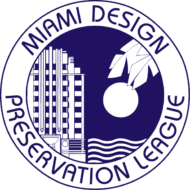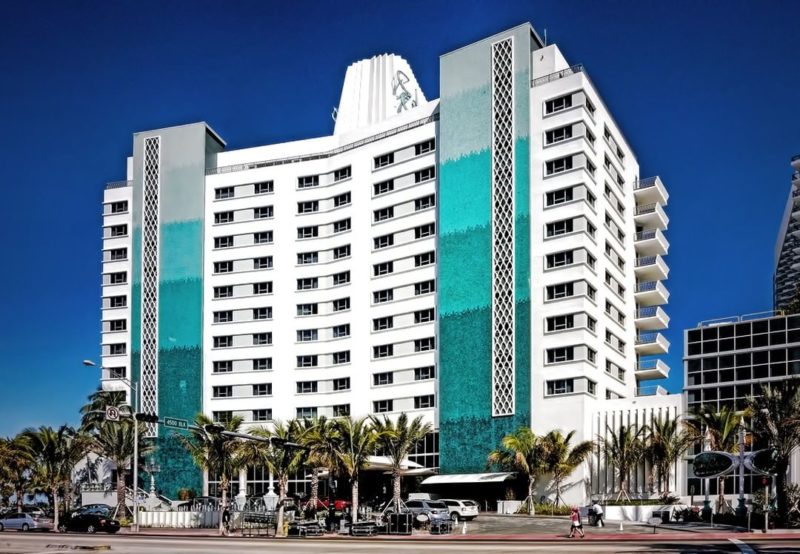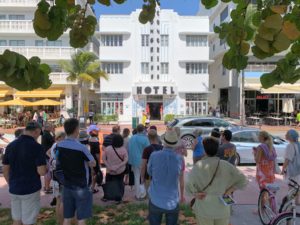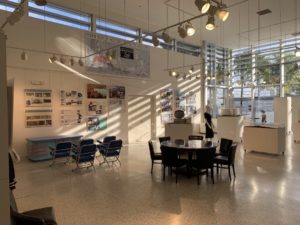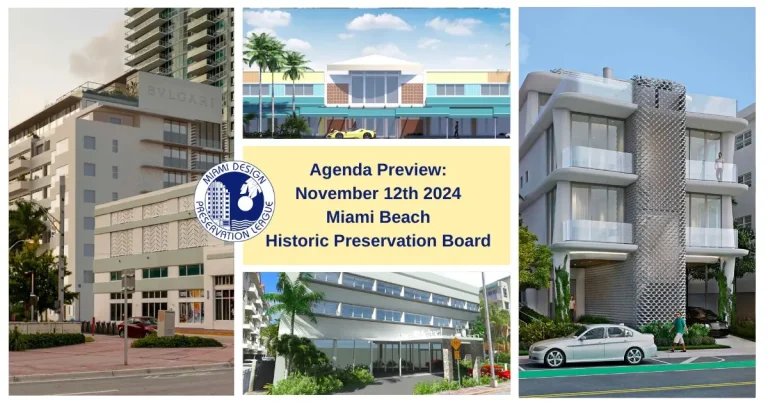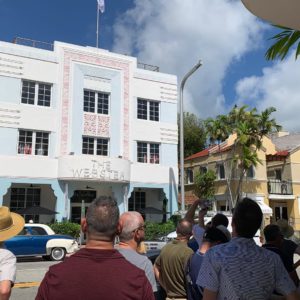[updated 2/8/22 to with results of meeting]
MDPL’s Advocacy Committee has reviewed the following applications and offers our positions below. Please note, the lack of a position on a project does not indicate support for or opposition to that project. To review the Historic Preservation Board full agenda, including public participation information:
CONTINUED ITEMS
6. HPB20-0440 a.k.a. HPB20-0380, 550 Washington Avenue
2/8 Update: Deferred to March 8th 2022 meeting, at the request of the applicant

An application has been filed requesting modifications to a previously issued Certificate of Appropriateness for the partial demolition and renovation of the existing building including the construction of attached additions and modifications to original public interior spaces and a variance to exceed the maximum permitted building height. Specifically, the applicant is requesting to modify a condition of the final order to allow for the introduction of new signage on the vertical feature along Washington Avenue, a Certificate of Appropriateness for modifications to the marquee and a variance to exceed the maximum permitted size for signage.
more details-> Paris Theater
City of Miami Beach Staff Report Recommendation (excerpt below, click here to read the full report):
Staff Analysis for 02/08/22: On November 9, 2021, the Board reviewed and continued the subject application to a date certain of January 11, 2022 in order to give the applicant additional time to address concerns expressed by the Board. The applicant has submitted revised plans, but the signage proposal remains unchanged, with the following exceptions:
- The design for the marquee replacement light box now includes horizontal lines to mimic the appearance of the original marquee sign rails.
- The applicant has provided renderings of proposals for additional signage on the Euclid Avenue façade. Staff would note that these signs are not part of the Board’s review at this time and would require a separate request for a certificate of appropriateness. Additionally, this signage may need to be modified to comply with the sign regulations set forth in the City Code.
Staff continues to be generally supportive of the application as noted below.
On September 8, 2020, the Board reviewed and approved modifications to the existing building including the construction of three small additions and interior modifications. As part of the proposed project, the existing “PARIS” signage located on the projecting vertical fin element along Washington Avenue was proposed to be restored. Additionally, the board imposed the following condition requiring that the Eiffel Tower icon be introduced:
I.C.1.a. The historic Paris signage located on the projecting vertical feature along Washington Avenue shall be restored inclusive of the Eiffel tower icon, in a manner to be reviewed and approved by staff consistent with the Certificate of Appropriateness Criteria and/or directions of the Board.
Vertical projecting fin signage
The applicant is currently requesting to eliminate this condition in order to introduce new signage with the name of the restaurant, “QUEEN”, replacing the existing “PARIS” signage. Two options have been presented to the Board for consideration, one with a Queen of Hearts scepter logo and the other without any logo.
Staff has no objection to the elimination of the condition and the signage replacement, as the proposed signs have been designed in a manner that is consistent with the original open-faced exposed neon signage of the theater. Additionally, as is often the case, the signage for this building has changed over time. The existing “PARIS” signage, which replaced the original “VARIETY” theater signage, was introduced in 1961. While staff believes that both options are suitable, Option 2 with the logo better captures the spirit of the early Post War Modern theater architecture.
Marquee signage
The applicant is also requesting approval for the replacement of the existing internally illuminated marquee signage boards with new edge lit aluminum panels. Staff is not supportive of the removal of this character defining feature of the historic theater building and strongly recommends that the existing marquee be restored in its entirety, including the signage boards. The retention of the marquee features will not preclude the applicant from introducing new signage consistent with the signage currently proposed.
VARIANCE ANALYSIS
The applicant is requesting the following variance:
1. A variance to exceed by up to 57.4 sq. ft. the maximum sign area allowed of 15.1 sq. ft. for wall signs in order to install two signs on either side of the projecting vertical fin with a total aggregate area of 72.5 sq. ft.
• Variance requested from:
Sec. 138-16. Wall sign.
Wall signs are signs attached to, and erected parallel to, the face of, or erected or painted on the outside wall of a building and supported throughout its length by such wall or building and not extending more than 12 inches from the building wall. Such signs shall be governed by the following chart:
Maximum area calculation, Wall Sign Design Standards per District, CPS-2: 0.75 square feet for every foot of linear frontage, with a minimum of 15 square feet permissible, regardless of linear frontage.
The applicant is proposing the installation of two signs on the prominent vertical element above the marquee facing Washington Avenue for a new restaurant and entertainment venue. The signs with the copy “QUEEN’ are proposed to be placed on the north and south sides consistent with the historic location of previous signs on the building. Although the Code allows the re-creation of historic signs regardless of the current regulations, the proposed signs do not technically qualify as a change of copy for a historic sign due to the proposed change in font.
The maximum sign area, based on the length of the street façade for this building, is 15.1 square feet. The larger of the two options proposed has an aggregate sign area of 72.5 square feet, which exceeds the maximum area allowed. Staff finds that the variance request satisfies the criteria for approval based on the retention of the historic building with the distinctive marquee and vertical signage fin that were designed by architect Henry Hohauser for the purpose of sign placement. In addition, the irregular shape of the property with minimal frontage on Washington Avenue, contributes to practical difficulties. As such, staff recommends approval of the variance as proposed.
RECOMMENDATION
In view of the foregoing analysis, staff recommends the application be approved, subject to the conditions enumerated in the attached draft Order, which address the inconsistencies with the aforementioned Certificate of Appropriateness criteria and Hardship and Practical Difficulties criteria, as applicable.
MDPL Position: We oppose the replacement of the historic PARIS sign with a new, larger QUEEN sign. We do not believe this is consistent with the original design of the building. We also request that the patron entry on the west side facing Flamingo Park residential neighborhood be prohibited. The Paris sign may not be original, but it has been in place for decades – far longer than the original sign – and demonstrates an element of our historic continuum worthy of preservation
NEW APPLICATIONS
7. HPB17-0176; 1685 Collins Avenue—Delano Hotel
2/8 Update: Application approved with conditions
An application has been filed requesting a Certificate of Appropriateness for the partial demolition, renovation and restoration of the existing building, including the reconstruction of original interior floor plates, modifications to the rear cabana building and site improvements.
more details -> delano hotel
City of Miami Beach Staff Report Recommendation (excerpt below, click here to read the full report)
Staff Analysis for 02/08/22: The Delano Hotel, constructed in 1947 and designed by architect B. Robert Swartburg, is an outstanding example of Art Deco architecture with Post War Modern influences. Notable features include, a sawtooth building form, multi-finned tower and numerous octagonal motifs including portholes and columns. The applicant is proposing the substantial renovation of the building and is currently requesting approval for several modifications including interior and exterior design modifications, the re-introduction of portions of the original mezzanine and rear dining room walls, modifications to the cabana building and site improvements.
Front yard and porch modifications
Within the front yard, the applicant is proposing to introduce a new driveway configuration that includes a reduction in the amount of paving and narrower curb cuts. Additionally, the dense hedges are proposed to be removed and replaced with low landscape material. These modifications are a welcome improvement over the current conditions and will open views to the historic front façade and will enhance the pedestrian experience along this portion of Collins Avenue.
Within the front porch area, the existing terrazzo steps and porch floor are proposed to be retained and restored. Additionally, a new accessible ramp is proposed to be introduced that will connect Collins Avenue to the front stair landing up to the porch level. Staff would note that this will require the removal of a portion of the porch railing. An additional ramp and step/landing are proposed to be introduced within the left side of the porch area to make the final connection from the porch to the lobby level. A matching step/landing is proposed to be introduced on the right side that maintain the original symmetrical design. These new ramps, steps and landings are proposed to be finished with terrazzo to match the existing.
Additionally, at the ground level of the front façade, the applicant is proposing to modify two existing windows openings in order to convert them into doors. The windows are located next to the entry doors and will provide access to the luggage room and café. Staff has no objection to the modifications which will allow for more efficient operations and could be easily reversed in the future.
Finally, the applicant is proposing to introduce a new water feature in place of the existing planter at the center of the porch. Staff would note that no microfilm plans have been located within the Building Department records. However, based on the terrazzo design that includes a border around this element, staff believes that this planter was an original design feature. Consequently, staff recommends that the shape of the planter be maintained if it is to be incorporated into a new water feature.
Lobby and mezzanine modifications
The applicant is proposing the renovation and partial restoration of the original hotel lobby in a manner that is compatible with the building’s architecture. Staff would note that the previous renovation by the industrial architect/designer Philippe Stark in 1994 obscured much of the
original lobby design through the introduction of dark wood flooring, wall paneling and column shrouds.
The renovation plans include the introduction of a new terrazzo floor, substantial restoration of the octagonal lobby columns, ceiling light coves and the extension of a new water feature within the lobby. Staff has no major objections to the proposed interior design, but recommends that further investigation occur relative to existence of any original terrazzo flooring underneath the wood floors. If original terrazzo flooring exists, staff recommends that it be retained, preserved and restored. If the condition of the terrazzo is such that it is beyond repair, staff recommends that a new terrazzo floor be introduced in a pattern and color to match the original. If no terrazzo flooring is present, staff has no objection to the terrazzo floor design as proposed.
The most notable modification to the lobby space is the re-introduction of the original mezzanine bridge. Staff would note that the bridge was demolished as part of the 1994 renovations. In 2020, the City Code, pursuant to voter approval, was amended to allow for the Historic Preservation Board to approve the reconstruction of original interior floor plates even if the site is non- conforming as to floor area ratio (FAR). Prior to these amendments, the reintroduction of the original floor plates could not be approved, because the site exceeds the maximum permitted FAR. Staff is extremely supportive of reintroduction of the mezzanine bridge and recommends that the Board approve the reintroduction of this original floor plate area.
Rear dining room and 4th level roof terraceAs part of the 1994 renovations, the angled portion of the rear dining room at the ground level was removed except for the wall parallel to 18th Street. The applicant is proposing to reconstruct portions of the original exterior wall and the entire roof to expand the outdoor covered dining area. Staff is supportive of the reintroduction of this area as it will contribute to a better understanding of the original building design. The roof of the expanded dining area will connect to the existing 4th level roof terrace and is proposed to contain a shallow pool, cabanas and dining area.
Modifications to the rear cabana structure and rear yard
The 2-story rear cabana structure is proposed to be renovated including the replacement of doors and windows and the extension of the northern parapet by 4’-0” in height to conceal existing mechanical equipment. Additionally, portions of the rear yard area are proposed to be renovated including landscape and hardscape enhancements. Staff has no significant concerns with the modifications proposed and believes that the overall design is appropriate for this causal beachfront area. However, staff would note that the cabanas located along the south property line do not appear to comply with the required setbacks. Finally, the applicant is proposing to introduce serval outdoor bar counters within the site. Staff has no objection to the modifications proposed as they will not have any adverse impact on the Contributing building and do not require the demolition of any significant architectural features. In
summary, staff is supportive of the proposed project and is recommending approval as noted below.
RECOMMENDATION
In view of the foregoing analysis, staff recommends the application be approved subject to the conditions enumerated in the attached draft Order, which address the inconsistencies with the aforementioned Certificate of Appropriateness criteria.
MDPL Position: We support the City of Miami Beach staff recommendations. It is great to see a historic property which will be revitalized and renovated without adding a new ground-level tower to the property. The applicants should be commended for their efforts.
8. HPB21-0481; 1901 Collins Avenue—Shore Club Hotel
2/8 Update: Deferred to March 8th 2022 meeting, at the request of the applicant
Scope of Work Overview
An application has been filed requesting a Certificate of Appropriateness for the partial demolition and renovation of two buildings on the site, the total demolition of two buildings, the construction of two new additions and landscape and hardscape modifications.
more details -> Shore Club Hotel
City of Miami Beach Staff Report Recommendation (excerpt below, click here to read the full report):
Staff Analysis for 02/08/22: The applicant is proposing a comprehensive renovation of the subject property which contains two Contributing hotel structures and multiple later additions. Additionally, the applicant is proposing to construct a new residential tower addition at the center of the site to replace the existing 20-story addition and a 2-story cabana structure at the eastern portion of the site. Further, landscape and hardscape improvements are proposed throughout the site.
Shore Club Hotel
The original 3-story Shore Club Hotel was constructed in 1949 and designed by Albert Anis in the Post War Modern style of architecture. In 1955, an 8-story attached addition, designed by Melvin Grossman, was constructed at the end of the south wing of the hotel. In 1997, the Joint DRB/HPB reviewed and approved a Certificate of Appropriateness for a 17-story addition, designed by David Chipperfield Architects, on top of the existing 3-story north wing of the hotel, for a total of 20- stories.
The applicant is currently proposing the renovation of the existing Shore Club hotel structure including the restoration of the primary façade facing Collins Avenue and the original lobby space. Proposed demolition includes the original south wing of the hotel, the attached 8-story rear addition constructed in 1955, a portion of the north wing and the entire 1998 Chipperfield addition. While the amount of demolition is significant, staff would note that the original wings of the hotel and the 1955 addition contain little in the way of significant architectural details and are not visible from Collins Avenue or from the Beachwalk. As such, staff has no objection to demolition requested.
Within the original hotel lobby, the applicant is proposing to retain and restore all significant architectural features including the cross shaped columns with cloud shaped ceiling details, terrazzo flooring and curved wall with sculpture. Additionally, the applicant is proposing to demolish the existing non-original reception desk and back of house spaces at the southern portion of the lobby in order to introduce a new lobby bar.
Cromwell Hotel
The Cromwell Hotel, constructed in 1939 and designed by Robert A. Taylor, is an excellent example of classic Art Deco, resort architecture. The structure incorporates significant nautical references including the stepped massing of the primary facade, culminating in a multi-tiered central element recalling a ship’s bridge, vertical window openings, raised vertical bands and portholes which define its towering ocean liner-like design character. In 1997, the Joint DRB/HPB reviewed and approved a Certificate of Appropriateness for a 1-story roof top addition, designed by David Chipperfield Architects, on top of the existing 7-story structure.
Lobby
The applicant is proposing to reconfigure the ground level floor plan of the structure to include a residential lobby connecting to the new residential tower and a new restaurant. Staff would note that the ground level of the hotel building including the lobby was subdivided over time. Staff has located the original ground level floor plan within the Building Department records which reveals that original lobby occupied the majority of the north side of the first floor and a dining room and kitchen were located at the south side.
Additionally, the applicant has provided images shown on page 15 of the historic resources report that document much of the original lobby design. Based upon the original floor plan and historical photographs, staff believes the original Cromwell Hotel lobby could be accurately restored including the geometry of the space, the octagonal columns and the flooring pattern and recommends as such.
External modifications
Along the north (20th Street) side of the building, the existing non-original stair is proposed to be removed and replaced with a new staircase designed in a manner more consistent with the architectural character of the building. Additionally, the architect is proposing the introduction of a new canopy structure over a portion of the front porch. Staff is supportive of the proposed design which has been inspired by the profile of the existing projecting eyebrow; however, staff is concerned that this new structure obscures this original architectural feature and could be perceived as part of the original design. As such, staff recommends the architect explore ways to further differentiate this feature which may include a greater separation vertically between the elements and/or a change in material between the new canopy and the existing building.
Along the east (ocean) side of the building, the applicant is proposing the introduction of projecting balconies. This modification will require the demolition of portions of the wall below the existing window openings. Staff has no objection to this request as this is a non-primary façade and will not require the demolition of any significant architectural features.
New residential tower addition
The applicant is proposing to construct a new 17-story residential addition within the center of the site, replacing the 1998 Chipperfield addition. The new tower will physically connect to both the Shore Club and Cromwell hotel buildings at the ground and second levels. The location within the center of the site (behind the Shore Club and Cromwell hotels) helps to minimize the visual impact of the tower from Collins Avenue. Additionally, the design of the eastern portion of the tower steps back at three intervals minimizing the perceived height of the addition from the Beachwalk and allowing for additional light and air to penetrate the site.
Staff is supportive of the design for the proposed addition as it has been developed in a manner that responds well to the existing buildings and site conditions. In this regard, the design of the proposed addition has been significantly influenced by the nautical architectural character of the Cromwell Hotel. Additionally, the glass to masonry ratio appropriately responds to the punched masonry character of both Contributing buildings on the site.
To the north of the Cromwell Hotel, the applicant is proposing to construct a 1-story service building that includes a ramp to the basement level parking, a loading area and additional back of house space. Staff believes that the loading spaces and associated wide curb cut along 20th Street will have an adverse impact on the character of the surrounding historic district. Consequently, staff recommends that the loading spaces be relocated within the basement which will allow for a reduction in the curb cut and will provide an opportunity to introduce additional landscaping, significantly enhancing the pedestrian experience along 20th Street.
Pool deck and accessory structures
The applicant is proposing a complete renovation of the rear pool deck area including the construction of multiple pools and decks, the demolition of the existing 2-story cabana structure and the construction of a new 2-story cabana building. The structures proposed within the rear yard have been designed in a manner compatible with the more casual beachfront environment. As such, staff has no objection to the improvements proposed.
RECOMMENDATION
In view of the foregoing analysis, staff recommends the application be approved subject to the conditions enumerated in the attached draft Order, which address the inconsistencies with the aforementioned Certificate of Appropriateness criteria.
MDPL Position: We are strongly opposed to the proposed demolition of the contributing Melvin Grossman addition of the historic Shore Club hotel. The proposal essentially keeps only the main lobby/facade of the Shore Club, leaving the bulk of floor area for the new condominium residence tower. Removal of such significant historic elements will erase the opportunity for visitors to experience seeing and inhabiting/staying at the historic Shore Club hotel rooms overlooking the Atlantic Ocean (see below red historic building proposed to be demolished)
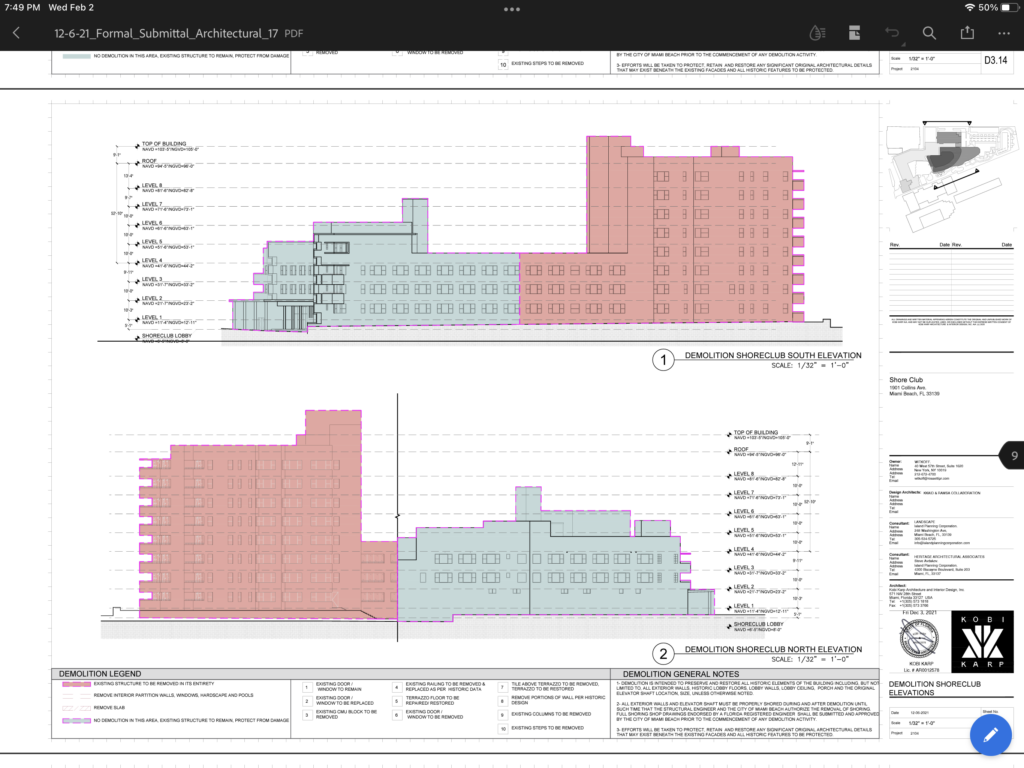
Overall, there is simply too much demolition being proposed for this property. We remain concerned about Sunny Isles-ification of Miami Beach. Contributing buildings should not be sacrificed to expand new construction.
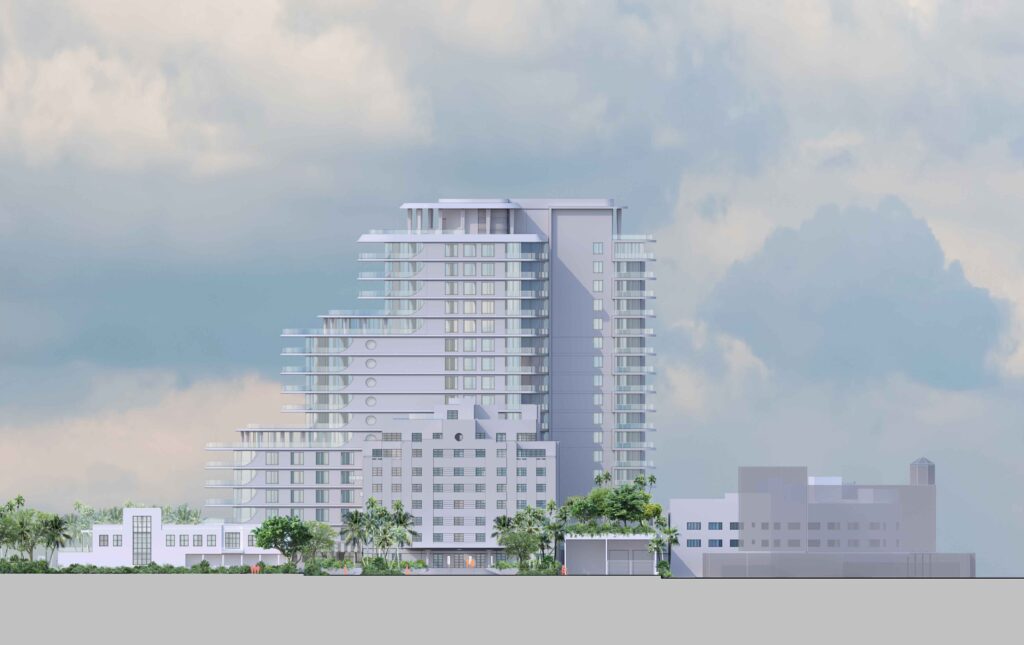
In view of the foregoing, MDPL opposes this application and asks that it be denied.
9. HPB21-0491; 1801 Collins Avenue—Shelborne Hotel
2/8 Update: Approved with conditions
An application has been filed requesting a Certificate of Appropriateness for the introduction of an electrical vault room within the rear yard of the site and variances from the required setbacks.
more details -> Shelbourne Hotel
City of Miami Beach Staff Report Recommendation (excerpt below, click here to read the full report):
Staff Analysis for 02/08/22: The original 14-story Shelborne Hotel was constructed in 1940 and designed by architects Polevitsky & Russell in the International Style of architecture. In 1957, an attached 8-story addtion desgined by Morris Lapidus in the Post War Modern style of architecture, was constructed to the west (in front of) the original hotel building. On April 13, 2021 the Historic Preservation Board apprved a Certificate of Appropriatness for several modifications to the building including interior and exterior design modifications, the introduction of a rooftop retractable canopy system at the mezzanine level and modifications to the rear yard site plan. The applicant has indicated that during the course of permitting, the existing Florida Power & Light (FPL) vault room located within the basement level of the hotel building was identified as insufficiently sized. In addition, the location of the vault room along the north side of the hotel building does not allow direct access from the street, a typical requirement of FPL. As a result, the applicant is requesting approval for the construction of a new FPL vault room building within the rear of the property.
The vault building is proposed to be located along 18th Street in place of an existing approximately 8’-8” tall site wall and will be accessed by FPL via the 18th Street street-end. The south elevation of the building (visible from 18th Street) has been designed in a manner that incorporates the highly prescribed requirements mandated by FPL. In order to mitigate what would otherwise be a utilitarian box, the applicant is proposing the introduction of vertical wood slats, recesses, and score lines resulting in a design that is more compatible with the surrounding environment.
Staff would note that the applicant did explore the possible location of the vault room within the existing hotel building. However, due to the access requirements of FPL, this would likely require the demolition of significant features of the building. As such, staff believes that the proposed location is the most appropriate solution for the site. Further, staff has no objection to the proposed design of the building and would note that the proposed architectural treatment helps to mitigate the appearance of this utilitarian structure from 18th Street. Finally, staff would note that the rear yard design has been modified and scaled back from the initial design approval last year.
VARIANCE ANALYSIS
As part of the introduction of the new FPL vault room building on the site, the applicant is requesting the following variances:
1. A variance to reduce by 15’-0” the minimum required side yard facing a street setback of 15’-0” for an accessory building in order to construct the new building at a zero (0’-0”) setback from the south side property line.
• Variance requested from:
Sec. 142-1132. – Allowable encroachments within required yards for districts other than single-family districts.
The following regulations shall apply to allowable encroachments in all districts except single-family residential districts, unless otherwise specified in this Code.
(a) Accessory buildings. Accessory buildings which are not a part of the main building may be constructed in a rear yard, provided such accessory building does not occupy more than 30 percent of the area of the required rear yard and provided it is not located closer than seven and one-half feet to a rear or interior side lot line and 15 feet when facing a street. Areas enclosed by screen shall be included in the computation of area occupied in a required rear yard lot but an open uncovered swimming pool shall not be included.
2. A variance to reduce by 15’-0” the minimum required side yard setback of 15’-0” for a structure located within the Oceanfront Overlay district in order to construct the new structure at a zero (0’-0”) setback from the south side property line.
Sec. 142-802. – Additional regulations for oceanfront lots.
These regulations apply to buildings and structures located west of the bulkhead line. Oceanfront lots shall have a minimum required rear yard setback of 50 feet at grade and subterranean levels measured from the bulkhead line in which there shall be no construction of any dwelling, hotel, apartment building, commercial building, seawall, parking areas, revetment or other structure incidental to or related to such structure except in accordance with the following provisions:
(3) There shall be a minimum required 15-foot setback from a side lot line and a minimum required ten-foot setback from the bulkhead line.
Both variances are directly related to the introduction of a new FPL vault room building for the site. As represented by the applicant, the existing vault room within the hotel basement level does not meet the requirements of FPL. The applicant has explored a number of potential locations for the vault room including within the building envelope and interior of the site. The access requirements mandated by FPL present significant challenges in locating this essential equipment. While one other potential option would be to locate the electrical vaults within the portion of the building fronting onto 18th Street or the portion along Collins Avenue, staff believes that this option would require the demolition of architecturally significant portions of the building resulting in irreparable harm to the integrity of the Contributing building.
Staff finds that the retention and restoration of the Shelborne Hotel including the partial restoration of a portion of the south façade and the unique and stringent requirements of Florida Power & Light create practical difficulties that warrant the approval of the requested variances. Further, the inability to provide power to the property would render the property unusable, establishing the hardship that justifies the variances requested.
RECOMMENDATION
In view of the foregoing analysis, staff recommends the application be approved including the variance requests, as modified, subject to the conditions enumerated in the attached draft Order, which address the inconsistencies with the aforementioned Certificate of Appropriateness criteria and Hardship and Practical Difficulties criteria, as applicable.
MDPL Position: We support the City of Miami Beach staff recommendations
